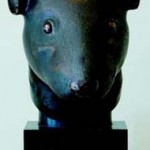Fashion icon Yves Saint Laurent recently died, leaving behind an enormous and valuable art collection. It’s on the auction block at Christie’s in Paris and is expected to make an astonishing 300 million pounds.
 About 20 million of that total is the estimated price of two 18th c. Chinese bronzes: a rat and a rabbit. Problem is, China says they were stolen and has put 69 lawyers on the case to get them back.
About 20 million of that total is the estimated price of two 18th c. Chinese bronzes: a rat and a rabbit. Problem is, China says they were stolen and has put 69 lawyers on the case to get them back.
The rat and rabbit were among 12 animals of the Chinese zodiac that were part of a fountain built for the Qing dynasty emperor by French and Italian Jesuit priests. They were allegedly taken in 1860 when allied French and British armies under the command of Lord Elgin sacked the palace after the imperial Government murdered British diplomats. The Chinese suit has echoes of Greece’s demand for the return from the British Museum of the Marbles that his father, the seventh Lord Elgin, removed from the Parthenon.
Family values imperalist style, I guess.
The legal case is a shaky one. A lot of priceless art has been stolen by invaders of various types. Getting it back is no easy feat.
Even with this particular zodiac set, China has had to buy pieces back when they’ve come up at other auctions, or they’ve received them as a gift from a wealthy benefactor, so there isn’t much in the way of precedent for legal success.
 China has only recently started taking action to end the near-constant drain of cultural patrimony. Policing all the historical sites in China is as close to impossible as these tasks get because of the massive size of the country, its enormous population, and many decades of governmental not-giving-a-shit.
China has only recently started taking action to end the near-constant drain of cultural patrimony. Policing all the historical sites in China is as close to impossible as these tasks get because of the massive size of the country, its enormous population, and many decades of governmental not-giving-a-shit.
The latter are coming to an end, though. One of former president George W. Bush’s last acts in office was to sign an import ban on a wide swath of Chinese antiquities.
This action against the Laurent auction may be a reflection of the Chinese government’s new focus on stopping the free-for-all trade in antiquities. It might also be sheer revenge for Sarkosy’s criticism of China’s Tibet policy.